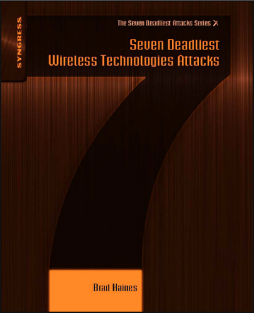
Additional Information
Book Details
Abstract
Seven Deadliest Wireless Technologies Attacks provides a comprehensive view of the seven different attacks against popular wireless protocols and systems. This book pinpoints the most dangerous hacks and exploits specific to wireless technologies, laying out the anatomy of these attacks, including how to make your system more secure. You will discover the best ways to defend against these vicious hacks with step-by-step instruction and learn techniques to make your computer and network impenetrable.
Each chapter includes an example real attack scenario, an analysis of the attack, and methods for mitigating the attack. Common themes will emerge throughout the book, but each wireless technology has its own unique quirks that make it useful to attackers in different ways, making understanding all of them important to overall security as rarely is just one wireless technology in use at a home or office. The book contains seven chapters that cover the following: infrastructure attacks, client attacks, Bluetooth attacks, RFID attacks; and attacks on analog wireless devices, cell phones, PDAs, and other hybrid devices. A chapter deals with the problem of bad encryption. It demonstrates how something that was supposed to protect communications can end up providing less security than advertised.
This book is intended for information security professionals of all levels, as well as wireless device developers and recreational hackers.
Attacks detailed in this book include:
- 802.11 Wireless—Infrastructure Attacks
- 802.11 Wireless—Client Attacks
- Bluetooth Attacks
- RFID Attacks
- Analog Wireless Device Attacks
- Bad Encryption
- Attacks on Cell Phones, PDAs and Other Hybrid Devices
"Seven Deadliest Wireless Technologies Attacks covers an array of wireless technologies and discusses the vulnerabilities and attacks associated with them, allowing the reader to fully understand not only HOW an attack works but WHY it works, using real-world examples supported by theory. This book is perfect for both penetration testers assessing these technologies and security managers who are tasked with managing the risks associated with them."--Tom Neaves, Senior Security Consultant at Verizon Business and Ph.D. Researcher at Royal Holloway, University of London
"I really, really liked this book. The chapters and the book are relatively short, but they are extremely to the point. The author has refrained from using overly technical language, and this fact makes this book perfect for novices and people who are forced to assume technical roles at home or at work. What I espeically liked is the large amount of real-world examples—they drive the point home and make for an interesting read. The text is peppered with notes, warnings and tips, and very enlightening 'Epic Fail' text boxes, where you can learn from other people's and companies' mistakes."--Help Net Security, October 04, 2010
